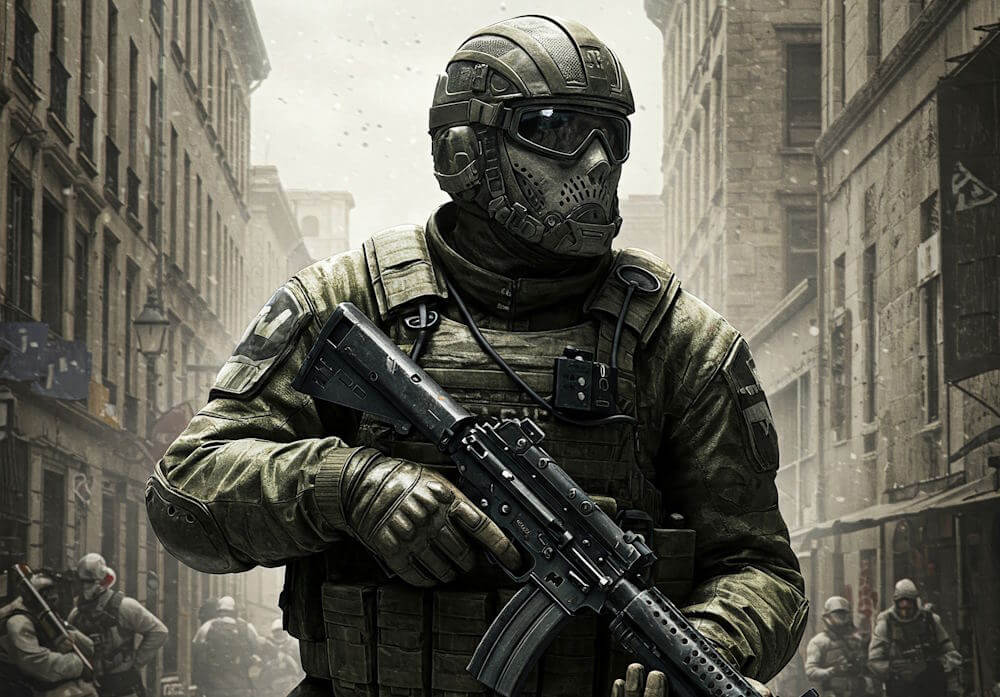The Call of Duty franchise, developed by Infinity Ward and Activision, has profoundly influenced the landscape of first-person shooters since its inception in 2003. Among the series’ various entries, the Modern Warfare sub-series stands out prominently, debuting with the release of Call of Duty 4: Modern Warfare in 2007. This title revolutionized the genre by introducing a contemporary setting combined with a gripping narrative that resonated with both casual gamers and enthusiasts alike. Its success not only led to a series of sequels but also redefined multiplayer gaming through its innovative matchmaking system.
As the Modern Warfare franchise grew, it expanded through multiple iterations, including notable titles such as Modern Warfare 2 and Modern Warfare 3. Each installment introduced new gameplay mechanics, graphical advancements, and engaging storylines centered around global conflicts and realistic warfare scenarios. The introduction of advanced game modes such as Spec Ops and the evolution of multiplayer experiences, including the iconic Call of Duty Warzone, have collectively contributed to the series’ longevity and popularity.
Moreover, the Modern Warfare series has consistently set benchmarks for the gaming industry, influencing numerous developers and establishing conventions in first-person shooter gameplay. As the franchise entered the current generation with the release of the 2019 reboot of Modern Warfare, it showcased the ability to adapt to changing gaming trends while retaining the core elements that fans love. However, as we approach the latest installment, Call of Duty: Modern Warfare III, discussions arise regarding the sustainability of the formula that has harnessed such impressive success. These conversations probe whether the established elements are becoming stale or if the series can continue to innovate and engage audiences in a fast-evolving gaming environment.
The Evolution of Multiplayer Gameplay
The multiplayer component of the Call of Duty: Modern Warfare series has undergone significant transformations since its inception. Central to the franchise’s appeal is its combat mechanics, which have evolved to offer players a more immersive experience. For instance, the introduction of enhanced movement options, such as sliding and vaulting, has added layers of complexity to player interactions. This evolution aims to create a dynamic battlefield that demands both strategic thinking and quick reflexes.
Team dynamics also play a crucial role in shaping the multiplayer experience. The incorporation of tactical gameplay elements, such as class systems and voice communication tools, has encouraged players to collaborate more effectively. Over the years, this has resulted in cooperative strategies becoming more prevalent, allowing teams to execute coordinated attacks or engage in defensive maneuvers. The emphasis on teamwork fosters a sense of camaraderie among players, enhancing the overall enjoyment of multiplayer sessions.
Another notable aspect is the design of maps, which has significantly influenced gameplay. Early Modern Warfare titles featured linear map layouts, focusing on infantry engagements and strategic choke points. As the series progressed, map designs have expanded to include open-world environments and verticality, allowing for a variety of playstyles and strategies. This diversity in map design has attracted different player demographics, catering to both aggressive players and those who prefer a more stealthy approach.
Despite these innovations, some critics argue that the core mechanics of the multiplayer experience have become repetitive. While new features have been integrated, the fundamental gameplay loop—shooting, respawning, and capturing objectives—remains largely unchanged. Thus, it is essential to evaluate whether these enhancements genuinely revive the experience or merely provide a fresh coat of paint on an aging formula.
Campaign Narrative and Characters
The single-player campaign of Call of Duty: Modern Warfare III continues to be a focal point of discussion among fans, particularly regarding its narrative arcs and character development. This installment offers a blend of established storytelling themes and innovative elements designed to engage players. At its core, the campaign seeks to explore deeper emotional connections between characters while maintaining the franchise’s hallmark intensity and action-adventure pacing.
One notable aspect of the narrative is the introduction of new characters alongside familiar faces from previous iterations. This dynamic allows for a diverse range of perspectives, showcasing the complexities of warfare through individual experiences. Characters are not just soldiers; they embody various facets of humanity amidst chaos, which adds layers to their actions and motivations. The emotional stakes are raised as players navigate not only combat missions but also personal conflicts that drive character development.
However, while some story elements feel fresh, there is a palpable reliance on classic tropes associated with military narratives. Themes of betrayal, sacrifice, and camaraderie recur throughout, mirroring the genre’s established formula. Although this can resonate with long-time fans of the series, it begs the question: does the reliance on these familiar themes render the experience predictable? Integrating innovative plot twists alongside traditional storytelling might be the key to retaining player interest without straying too far from what has made the franchise successful.
As players progress through the campaign, they may find themselves evaluating the balance between nostalgia and novelty in the storytelling. If executed well, this blend could capture both new players and veterans. Ultimately, the challenge lies in crafting a campaign narrative that evolves with the audience, ensuring Modern Warfare III maintains its relevance in an ever-expanding gaming landscape.
Graphics and Technical Advancements
The visual and technical enhancements in Call of Duty: Modern Warfare III play a significant role in shaping the overall gameplay experience. As gamers increasingly demand higher fidelity graphics and seamless performance, this installment in the franchise aims to deliver on those expectations with a variety of upgrades. From the moment players enter the game, they are greeted with stunning graphics that feature detailed character models, realistic environments, and dynamic lighting effects that enhance immersion.
One of the most notable advancements in Modern Warfare III is its upgrade to the graphics engine, allowing for greater detail and realism in environments. Terrain textures appear more nuanced and lifelike, and the addition of advanced particle effects enriches the atmosphere of battle. Moreover, the use of high dynamic range (HDR) emphasizes contrasts between light and shadow, giving players a more immersive experience as they navigate various combat scenarios. The effects of weather and time of day also contribute to the changing game dynamics, which differentially affect visibility and tactics.
Beyond graphics, technical innovations such as improved artificial intelligence (AI) contribute substantially to gameplay. NPCs exhibit smarter behavior, reacting more realistically to threats and enhancing the challenge. This creates a competitive and engaging atmosphere that prompts players to adapt their strategies on the fly. Furthermore, new features, such as destructible environments, allow players to manipulate the battlefield creatively, fundamentally altering how maps can be approached.
Such advancements invite a critical evaluation of whether Modern Warfare III is pushing the limits of the franchise or simply maintaining an established formula. As technology continues to evolve, the expectations from titles in this genre grow, demanding developers to innovate rather than iterate. The enhancements in graphics and technical performance in this release certainly reflect a step forward, but whether this is enough to satisfy a discerning audience remains to be seen.
Community and Player Reception
The gaming community has expressed a diverse range of opinions regarding Call of Duty: Modern Warfare III. As the title has been anticipated for years, player reception has been a focal point of discussion across multiple platforms. Reviews from various gaming websites suggest that while there are elements that players appreciate, there are also significant criticisms that have emerged, reflecting a broader dialogue about the state of the franchise.
On gaming forums, many players have lauded the advancements in graphics and gameplay mechanics. Gamers appreciate the effort made to create a more immersive experience with revamped visuals and sound design, which enhances the overall enjoyment. A common sentiment is the excitement about new features and maps that have been introduced, showcased in various trailers and promotional content. Discussions around these innovations often receive positive feedback, indicating a welcoming attitude towards refreshing elements in the gameplay.
However, the community has not shied away from voicing its concerns. Many players have pointed out that the core mechanics of the game feel familiar and, in some instances, repetitive. Critiques surrounding the campaign narrative and multiplayer modes reflect worries that the established formula might be feeling tired. The phrase “more of the same” echoes through social media posts, with some veterans of the series expressing disappointment over perceived lack of innovation. These discussions often highlight the tension between nostalgia for classic gameplay and the desire for new experiences.
Overall, the response to Modern Warfare III captures a range of emotions, from excitement to skepticism. As the community continues to engage with the game, feedback will likely influence future installments. The balance between maintaining the franchise’s identity and offering fresh experiences remains a crucial topic among players.
Comparative Analysis with Previous Titles
The Call of Duty franchise has long been a cornerstone of the first-person shooter genre, with the Modern Warfare series notably contributing significantly to its enduring popularity. In analyzing Modern Warfare III in comparison to its predecessors, one must carefully examine gameplay mechanics, storyline depth, character development, and overall player engagement. Each of these elements shapes the player’s experience and highlights whether the series has effectively evolved or if it has become stagnant.
When considering gameplay mechanics, Modern Warfare III introduces several refinements but also bears resemblance to earlier titles. Traditional elements like the kill-death ratio, weapon customization, and multiplayer modes are present, reflecting the successful features that have defined the franchise. However, innovation in tactics and strategies might seem limited when juxtaposed with innovations from previous installments like Modern Warfare 2, where gameplay mechanics were significantly revamped. This leads to questions about whether the current formula remains compelling for both new players and veterans of the series.
The storyline in Modern Warfare III carries forward familiar themes of conflict and heroism, continuing the narratives established in earlier titles. Yet, the character arcs often feel repetitive, recycling notable tropes from past games that fans have become accustomed to. While character development remains an integral part of the experience, the predictability may detract from the freshness that earlier games successfully delivered. Comparatively, Modern Warfare had a unique ability to blend complex narratives with emotional depth, drawing players in. Such engagement appears to be diluted in the latest installment.
Overall player engagement is another critical factor in evaluating Modern Warfare III. While the visuals and sound design have undeniably improved, some players argue that the essence of what made the series special is fading. The advantages of cutting-edge graphics may not wholly compensate for a sense of déjà vu regarding gameplay and narratives. Thus, upon analyzing the latest title against its forerunners, it becomes clear that the franchise is at a crossroads, contemplating the balance between leveraging long-standing elements and exploring new ideas to invigorate its offerings.
The Role of Innovation in Gaming
Innovation plays a crucial role in the gaming industry, significantly influencing how players experience and engage with games. As the landscape continuously evolves, developers are tasked with both revitalizing and adapting existing game formulas to capture and maintain player interest. The ability to innovate not only keeps gameplay fresh but also encourages players to explore new genres and mechanics that challenge traditional gaming paradigms.
One prominent trend is the integration of cutting-edge technologies, such as virtual reality (VR) and augmented reality (AR). These technologies redefine how players interact with the game world, fostering immersive experiences that were previously unimaginable. Furthermore, cross-platform play has emerged as a vital feature, allowing gamers from various devices to connect and compete, thus expanding the player base and enhancing community engagement.
In the context of the Call of Duty franchise, the incorporation of unique gameplay mechanics can reinvigorate the series. The introduction of diverse multiplayer modes, dynamic environments, and evolving storylines can significantly enhance player engagement. As seen in other successful titles, the blending of genres can lead to innovative gameplay experiences, pushing boundaries and offering players something distinctly different from traditional first-person shooters.
Moreover, the rise of user-generated content is another innovation that has enriched the gaming experience. By allowing players to create and share their own content, developers can tap into the community’s creativity, fostering a sense of ownership and investment in the game. This approach not only extends the game’s lifecycle but also reinforces the value of innovation in attracting new audiences.
Ultimately, the role of innovation in gaming cannot be understated. As game developers continue to explore new technologies, mechanics, and trends, the ability to adapt and refresh established formulas will be key in maintaining player engagement and ensuring the longevity of franchises like Call of Duty.
Future of the Call of Duty Franchise
The Call of Duty franchise has historically played a significant role in shaping the first-person shooter genre. As we look forward to the post-Modern Warfare III landscape, it is essential to consider how the series can adapt to maintain its relevance in an increasingly competitive gaming market. The community’s expectations, coupled with emerging gaming trends, will likely guide the future direction of this iconic franchise.
One compelling avenue for innovation is the potential expansion into immersive storytelling. While the franchise has certainly utilized narrative-driven campaigns in past iterations, there is an opportunity to delve deeper into character development and complex themes. Players are increasingly drawn to narratives that reflect real-world issues or explore more profound emotional landscapes. By enhancing the storylines and character arcs in future titles, the franchise could not only engage players more effectively but also differentiate itself from the multitude of other shooters available.
In terms of gameplay innovations, integrating cutting-edge technology such as virtual reality (VR) or augmented reality (AR) might redefine how players experience the game. The rise of esports and online multiplayer environments offers an additional opportunity for the franchise to grow. Focusing on competitive play, including a refined ranking system and improved matchmaking algorithms, could significantly enhance player satisfaction. Regular updates and seasonal content could also keep the community engaged year-round, reinforcing player loyalty.
Finally, player feedback should play a crucial role in shaping future editions. The franchise has a vibrant community that is vocal about its desires and grievances. By listening to its audience and implementing changes based on feedback, Call of Duty can evolve in ways that resonate with both long-time fans and newcomers alike. Ultimately, the franchise’s ability to innovate while respecting its roots will be key to sustaining its legacy in the gaming industry.
Conclusion: Resilience of the Call of Duty Formula
As we reflect on the ongoing legacy of the Call of Duty franchise, particularly in relation to Modern Warfare III, it becomes clear that the formula it established has undergone substantial evolution over the years. While some players may argue that the series has become formulaic and repetitive, there remain compelling arguments suggesting that the core elements of engagement, competitive play, and narrative depth still resonate with a significant audience. The question of whether the Modern Warfare formula is tired is multifaceted and warrants consideration from various perspectives.
Innovations in gameplay mechanics, advancements in audio-visual fidelity, and contemporary storytelling techniques are markers of how the franchise continuously seeks to reinvigorate itself. The relentless pursuit of realism and dynamic game play reflects an industry standard that Call of Duty has both influenced and adhered to. However, the risk of complacency is ever-present; modernization that strikes a balance between tradition and novelty will be critical in sustaining player interest over time. It is possible the franchise can rejuvenate its innovative spirit by infusing fresh ideas without alienating its core fan base.
In analyzing the cyclical nature of gaming trends, it becomes apparent that franchises like Call of Duty face the constant challenge of evolution within the realm of audience expectations. The interplay of nostalgia and innovation defines the experiences players seek, underscoring the importance of continually refreshing gameplay while honoring the elements that have made the series iconic.
Only time will determine if Modern Warfare III can navigate these turbulent waters successfully. Ultimately, the resilience of the Call of Duty formula is tested with each release, signaling a pivotal moment in the franchise’s journey. It remains to be seen whether it can truly reclaim its innovative edge or risk stagnation in an ever-changing gaming landscape. This ongoing dialogue around the series will likely inform not only its future but also the broader trajectory of first-person shooters as a genre.



